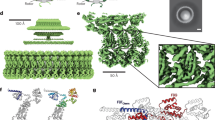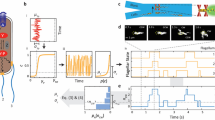Abstract
BACTERIA such as Escherichia coli and Salmonella typhlmurium swim by rotating their flagella1,2, each of which consists of an external helical filament and a rotary motor embedded in the cell surface (see ref. 3 for a review). The function of the flagellar motor has been examined mainly by tethering the flagellar filament to a glass slide and observing the resultant rotation of the cell body2. But under these conditions the motor operates at a very low speed (about lOr.p.s.) owing to the unnaturally high load conditions inherent in this technique. Lowe et al.4 analysed the frequency of light scattered from swimming cells to estimate the average rotation speed of flagellar bundles of E. coli as about 270 r.p.s. To analyse motor function in more detail, however, measurement of high-speed rotation of a single flagellum (at low load) with a temporal resolution better than 1 ms is needed. We have now developed a new method—laser dark-field microscopy—which fulfils these requirements. We find that although the average rotation speed of S. typhimurium flagella is rather stable, there are occasional abrupt slowdowns, pauses and reversals (accomplished within 1 ms). These changes were frequently observed in mutants defective in one of the motor components (called the switch complex), suggesting that this component is important not only in switching rotational direction but also in torque generation or regulation.
This is a preview of subscription content, access via your institution
Access options
Subscribe to this journal
Receive 51 print issues and online access
$199.00 per year
only $3.90 per issue
Buy this article
- Purchase on Springer Link
- Instant access to full article PDF
Prices may be subject to local taxes which are calculated during checkout
Similar content being viewed by others
References
Berg, H. C. & Anderson, R. A. Nature 245, 380–382 (1973).
Silverman, M. & Simon, M. Nature 249, 73–74 (1974).
Macnab, R. M. in Escherichia coli and Salmonella typhimurium: Cellular and Molecular Biology (eds Neidhardt, F. C. et al) 70–83, (Am. Soc. Microbiol., Washington, 1987).
Lowe, G., Meister, M. & Berg, H. C. Nature 325, 637–640 (1987).
Holwill, M. E. J. & Burge, R. E. Arch. Biochem. Biophys. 101, 249–260 (1963).
Yoshida, T., Shimada, K. & Asakura, S. J. mechanochem. Cell Motil. 3, 87–98 (1975).
Macnab, R. M. J. clin. Microbiol. 4, 258–265 (1976).
Hotani, H. J. molec. Biol. 106, 151–166 (1976).
Adler, J. & Templeton, B. J. gen. Microbiol. 46, 175–184 (1967).
Berg, H. C. in Cell Motility (eds Goldman, R., Pollard, T. & Rosenbaum, J.) 47–56 (Cold Spring Harbor Laboratory, New York, 1976).
Block, S. M. & Berg, H. C. Nature 309, 470–472 (1984).
Blair, D. F. & Berg, H. C. Science 242, 1678–1681 (1988).
Yamaguchi, S. et al. J. Bact. 168, 1172–1179 (1986).
Berg, H. C. Nature 249, 77–79 (1974).
Magariyama, Y., Yamaguchi, S. & Aizawa, S.-I. J. Bact. (in the press).
Author information
Authors and Affiliations
Rights and permissions
About this article
Cite this article
Kudo, S., Magariyama, Y. & Aizawa, SI. Abrupt changes in flagellar rotation observed by laser dark-field microscopy. Nature 346, 677–680 (1990). https://doi.org/10.1038/346677a0
Received:
Accepted:
Issue Date:
DOI: https://doi.org/10.1038/346677a0
This article is cited by
-
Flagellar rotational features of an optically confined bacterium at high frequency and temporal resolution reveal the microorganism’s response to changes in the fluid environment
European Biophysics Journal (2022)
-
Planar photonic chips with tailored angular transmission for high-contrast-imaging devices
Nature Communications (2021)
-
Smartphone-based multi-contrast microscope using color-multiplexed illumination
Scientific Reports (2017)
-
Identical folds used for distinct mechanical functions of the bacterial flagellar rod and hook
Nature Communications (2017)
-
Direct observation of rotation and steps of the archaellum in the swimming halophilic archaeon Halobacterium salinarum
Nature Microbiology (2016)
Comments
By submitting a comment you agree to abide by our Terms and Community Guidelines. If you find something abusive or that does not comply with our terms or guidelines please flag it as inappropriate.



